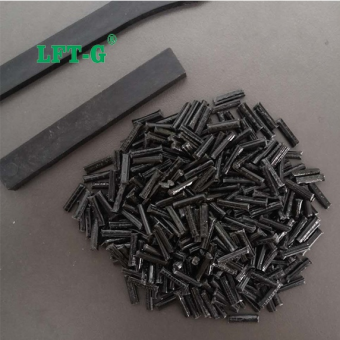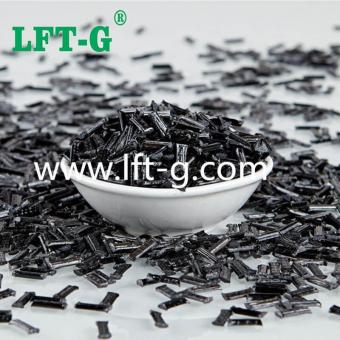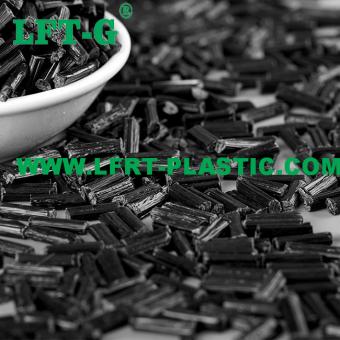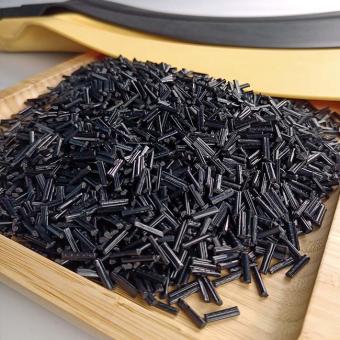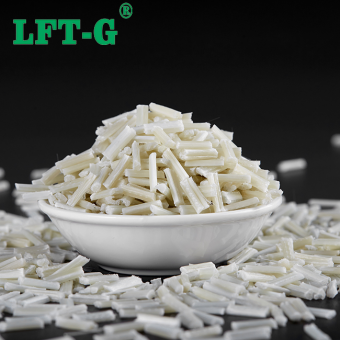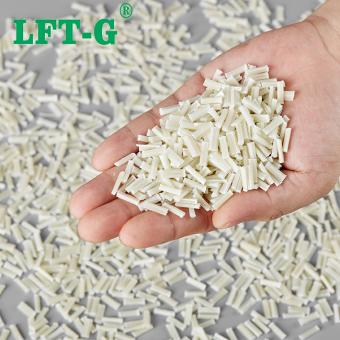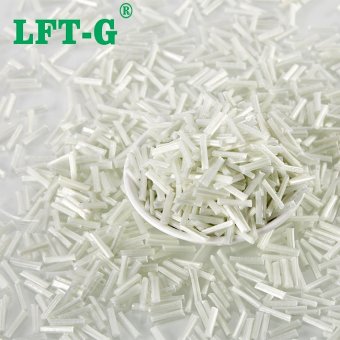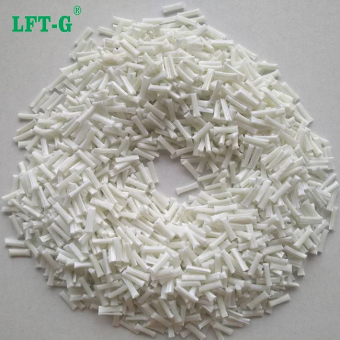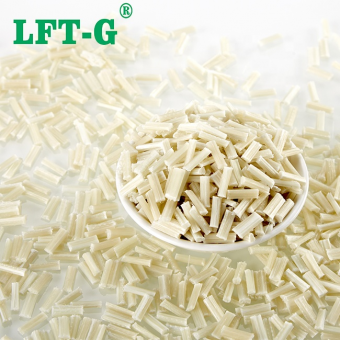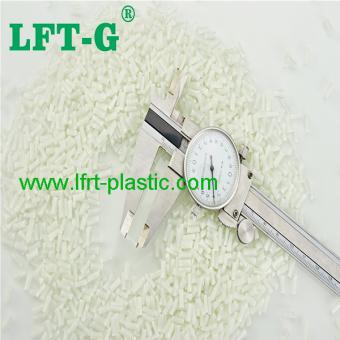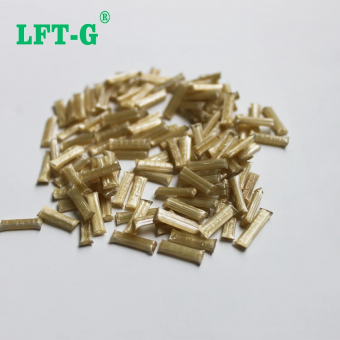-
Xiamen LFT Polyamide 12 filling long carbon fiber compounds high impact resistance for car partsLong carbon fiber Carbon fiber has many excellent properties, high axial strength and modulus, low density, high specific performance, no creep, super high temperature resistance in non-oxidizing environment, good fatigue resistance, specific heat and electrical conductivity between non-metal and metal, small coefficient of thermal expansion and anisotropy, good corrosion resistance, good X-ray transmission. Good electrical and thermal conductivity, good electromagnetic shielding, etc. Compared with traditional glass fiber, carbon fiber has more than 3 times of Young's modulus; it is about 2 times of Young's modulus compared with Kevlar fiber, which is insoluble and swollen in organic solvents, acids and alkalis, and has outstanding corrosion resistance. But is there a way to reduce the price of carbon fiber? That is to mix it with relatively cheap nylon material to form a composite material with good performance and meet the requirements. In that case, there is no doubt that carbon fiber nylon will definitely have a place in the composite material. Nylon itself is an engineering plastic with excellent performance, but moisture absorption, poor dimensional stability of products. Strength and hardness are also far from metal. In order to overcome these shortcomings, as early as before the 70s. People have used carbon fiber or other varieties of fibers for reinforcement to improve its performance. Carbon fiber reinforced nylon materials have developed rapidly in recent years, because nylon and carbon fiber are excellent performance in the field of engineering plastics materials, its compound material synthesis reflects the superiority of the two, such as strength and rigidity than unreinforced nylon is much higher, high temperature creep is small, thermal stability has improved significantly, good dimensional accuracy, wear resistance. Excellent damping, compared with glass fiber reinforced has better performance. Therefore, carbon fiber reinforced nylon (CF / PA) composites have developed rapidly in recent years. And for 3D printing using SLS technology is the most suitable technical means to achieve carbon fiber reinforced nylon. TDS for reference Application production process Company profile Xiamen LFT composite plastic Co., Ltd is a brand-name company that focuses on LFT&LFRT. Long Glass Fiber Series (LGF) & Long Carbon Fiber Series (LCF). The company's thermoplastic LFT can be used for LFT-G injection molding and extrusion, and can also be used for LFT-D molding. It can be produced according to customer requirements: 5~25mm in length. The company's continuous infiltration reinforced thermoplastics have passed ISO9001&16949 system certification, and the products have obtained lots of national trademarks and patents.
- long fibre reinforced thermoplastics
- carbon fiber reinforced plastics granules
- long carbon fiber reinforced pa12
- long fiber composite pa6 granules
- pure PA 12 manufacturers supplier factory CFRP
- pa6 lcf CF 30 car frame
Tags :
-
Xiamen LFT-G PLA Polylactic acid composite long carbon fiber thermoplastic resinWhat is long carbon fiber PLA? While biobased polylactic acid (PLA) thermoplastics are relatively eco-friendly and easy to recycle, composites such as carbon fibre are much stronger. Long carbon fiber reinforced PLA is an outstanding material that is strong, lightweight, has excellent layer bonding and low warpage. It has excellent layer adhesion and low warpage. Long carbon fiber PLA is stronger than other 3D-printed materials. Long carbon fiber filaments are not as strong as other 3D materials, but tougher. The increased rigidity of carbon fiber means increased structural support but reduced overall flexibility. It is slightly more brittle than regular PLA. When printed, the material is a dark glossy color that shimmers slightly under direct light. What is long carbon fiber? Long carbon fiber reinforced composites offer siginificant weight savings and provide optimum strength and stiffness properties in reinforced thermoplastics. The excellent mechanical properties of long carbon fiber reinforced composites make it an ideal replacement for metals. characteristic The fracture strain is moderate (8-10%), so the silk is not brittle, but strong toughness Very high melt strength and viscosity Good dimensional accuracy and stability Easy to handle on many platforms High attractive matte black surface Excellent impact resistance and lightness Application of long carbon fiber PLA materials Long carbon fiber PLA is an ideal material for frame, support, shell, propeller, chemical instrument and so on. Drone makers and RC enthusiasts especially like it, too. Ideal for applications requiring maximum stiffness and strength. Details Number PLA-NA-LCF30 Color Original black (can be customized) Length 12mm (can be customized) MOQ 20kg Package 20kg/bag Sample Available Delivery time 7-15 days after shipment Port of Loading Xiamen Port Exihibition We will offer you: 1. LFT & LFRT material technical parameters and leading edge design 2. Mold front design and recommendations 3. Provide technical support such as injection molding and extrusion molding
- PLA LCF original color resin made in China
- Polylactic acid filling long carbon fiber
- PLA resin lcf reinforced plastic pellets
- LFT cpmpounds pla manufacturer direct sell
- lcf reinforced material pla good price
- Thermoplastic pla lcf instead metal CF
Tags :
-
LFT-G PPS Polyphenylene sulfide with long carbon fiber thermoplastic resin high rigidity and strengthPPS Information Polyphenylene sulfide (PPS) is not enhanced before modification, its disadvantages are brittle, poor toughness, low impact strength, after filling glass fiber, carbon fiber and other enhancements modified to overcome the above shortcomings, to obtain very good overall performance. PPS filling Long carbon fiber In the modified engineering plastics industry, long fiber reinforced composites are composites made from long carbon fibers, long glass fibers and polymer matrix through a series of special modification methods. The most important feature of long fiber composites is that they have superior performance that the original materials do not have. If we classify them according to the length of the reinforcing materials added, they can be divided into: long fiber, short fiber and continuous fiber composites. Long carbon fiber composites are one kind of long fiber reinforced composites, which are a new fiber material with high strength and high modulus. It is a new material with excellent mechanical properties and many special functions. Corrosion resistance: LCF carbon fiber composite materials have good corrosion resistance and can adapt to the harsh working environment. UV resistance: the ability to resist UV is strong, and the products are less damaged by UV. Abrasion and impact resistance: the advantage of comparing with general materials is more obvious. Low density: lower density than many metal materials, can achieve the purpose of light weight. Other properties: such as reducing warpage, improving rigidity, impact modification, increasing toughness, electrical conductivity, etc. LCF carbon fiber composites have higher strength, higher rigidity, lower weight, and excellent electrical conductivity compared with glass fiber. PPS TDS for reference PPS Application Other products you can also contact us for more technical advice. Q&A 1. Are carbon fiber composite products very expensive? The price of carbon fiber composite products is closely related to the price of raw materials, the level of technology and the number of products. The higher the performance of the raw material, the more expensive it is, such as the carbon fiber PEEK thermoplastic material used in orthopedics. Of course, the more complex the manufacturing process, the greater the working time and workload, and the increased production costs. However, the larger the order quantity, the lower the cost per product. In the long run, the superior performance of carbon fiber will extend the life of the product, reduce the number of maintenance, and is also very beneficial to reduce the cost of use. 2. Are carbon fiber composite products toxic? Carbon fiber composites are made of carbon fiber filaments mixed with ceramics, resins, metals and other substrates, and are generally not toxic. For example, the above-mentioned PEEK material is made of food-grade resin, which is very compatible with the human body and is not only harmless to humans, but also becomes a more ideal material for orthopedic surgery because of its high strength and elastic modulus close to the bone cortex. Carbon fiber medical bed plate, will be in daily contact with many patients body, will not have adverse effects on the human body, on the contrary, for the accuracy of medical diagnosis and a great help. 3. What is the difference between thermosetting carbon fiber composites and thermoplastic carbon fiber composites? Thermoset carbon fiber composites favor the role of curing agent in curing and molding. While thermoplastic carbon fiber composite products mainly rely on cooling down to achieve the shaping. Thermoplastic carbon fiber composites are not as popular as thermoset carbon fiber composites, mainly because they are expensive and are generally used in high-end industries. Thermoset carbon fiber composites are difficult to recycle due to the limitation of the resin matrix itself, and are generally not considered; thermoplastic carbon fiber composites can be recycled, and can be made twice as long as they are heated to a certain temperature. About us We will offer you: 1. LFT & LFRT material technical parameters and leading edge design 2. Mold front design and recommendations 3. Provide technical support such as injection molding and extrusion molding
- PPS polyphenylent with addition and filler
- Low warpage electronic appliance
- pps lcf40 granules raw material
- PPS long carbon fiber extrusion
- pps LCf40 plastic injection part
- carbon fibre reinforced pps lcf pellet
Tags :
-
Xiamen LFT-G PP Polyphenylene with long carbon fiber thermoplastic resin original colorPP material Polypropylene fiber has remarkable performance. Compared with other fibers, polypropylene fiber has the lightest, warmest and most hydrophobic fiber properties. The density of polypropylene fiber is only 0.91g/cm3, which is the smallest among the five synthetic fibers and about 34% lighter than polyester fiber; the insulation rate of polypropylene fiber is 36.49%, which is the highest among the five synthetic fibers and 1.7 times that of polyester; the standard moisture regain rate of polypropylene fiber is almost zero, and the hydrophobic and moisture-conducting properties are the best. At the same time, polypropylene fiber has good acid and alkali resistance and heat aging properties. PP-LGF reinofrced material Long carbon fiber reinforced composites can solve your problems when other methods of reinforced plastics do not provide the performance you need or if you want to replace metal with plastic. Long carbon fiber reinforced composites offer significant weight savings and provide optimum strength and stiffness properties in reinforced thermoplastics. The excellent mechanical properties of long carbon fiber reinforced composites make it an ideal replacement for metals. Combined with the design and manufacturing advantages of injection molded thermoplastics, long carbon fiber composites simplify the re-imagining of components and equipment with demanding performance requirements. Its widespread use in aerospace and other advanced industries make it and a "high-tech" perception of consumers - you can use it to market products and create differentiation from competitors. Datasheet of PP-LCF Injection molding Aplication of PP-LCF More suitable for large parts and structural parts. Other application fields you can contact us for technical supports. Test 1. Heat Deflection Temperature Testing 2. Vicat Softening Temperature Testing 3. Tensile Testing 4. Flexural Strength Testing 5. Elongation Testing 6. Density Testing 7. Melt Flow Rate Testing 8. Impact Strength Testing. 9. Etc. Production process 1. The original carbon fiber is physically and chemically treated to remove impurities, improve surface activity, and enhance the mechanical properties and durability of the prepreg. 2. Add resin, curing agent, additives, etc. to form a formula to improve fluidity, hardness, and temperature stability. 3. The pretreated carbon fiber is placed on the machine and compounded with resin. 4. The machine solidifies the words and the two are fully bonded. 5. Cut into 5mm-24mm particles according to the needs of manufactured products。 Certification 1. Quality Management System ISO9001/16949 Certification 2. National Laboratory Accreditation Certificate 3. Modified Plastics Innovation Enterprise 4. Honorary Certificate 5. Heavy metal REACH & ROHS testing Frequently asked questions Q. What are the advantages of long carbon fiber materials? A. Thermoplastic LFT long carbon fiber material has high rigidity, good impact strength, low warpage, low shrinkage, electrical conductivity and electrostatic properties, and its mechanical properties are better than glass fiber series. Long carbon fiber has the characteristics of lighter and more convenient processing to replace metal products. Q. Are there any special process requirements of long carbon fiber injection molding products? A. We must consider the requirements of long carbon fiber for the injection molding machine screw nozzle, mold structure and injection molding process. Long carbon fiber is a relatively high cost material, and need to evaluate the cost performance problem in the selection process. Q. The cost of long fiber products is higher. Does it has a high recycling value? A. The thermoplastic LFT long fiber material can be recycled and reused very well
- Long carbon fiber Reinforced Polypropylene for electrial accessories
- self owing pp pellets producer whole sell
- best long carbon fiber pp lcf30 granules
- PLA Composite Pellets good price made in China
- Modified Plastic pellets home appliances resin
- pp modified granules manufacturer
Tags :
-
Xiamen LFT high strength PBT reinforced plastic Long Glass Fiber filled compoundsPBT materials Polybutylene terephthalate (PBT) is a thermoplastic polyester and one of the top five engineering plastics. PBT has excellent overall performance, is one of the toughest engineering plastics, and has high dimensional stability, good chemical resistance, excellent electrical insulation, good mechanical properties and elasticity, low water absorption, etc. PBT filling Long glass fiber compounds PBT (polybutylene terephthalate) is a polyester-based plastic, while glass fiber is a reinforcing material that is usually added to plastics in fiber form to enhance their mechanical properties. When PBT is combined with glass fibers, the following effects occur: 1. Enhanced strength and stiffness: glass fiber has excellent strength and stiffness, and adding it to PBT can significantly increase the mechanical properties of the plastic. This makes the material of PBT with glass fiber more strong and rigid when it is subjected to force or stress, and less likely to deform or break. 2. Improve heat resistance: glass fiber has a high melting point and good heat resistance performance. When glass fiber is added to PBT, it can improve the heat resistance of PBT, so that it can keep better performance at higher temperature and prevent softening or melting. 3. Improve corrosion resistance: Glass fiber has excellent corrosion resistance, and adding it to PBT can improve its resistance to chemicals, solvents and other corrosive media. This makes PBT with glass fiber have longer service life in some special environments. 4. Improve insulation performance: PBT itself has good insulation performance, and the addition of glass fiber further improves the insulation performance of PBT material. This makes the PBT with glass fiber more suitable for electrical and electronic applications, which can effectively isolate the current and reduce leakage and electromagnetic interference. All in all, PBT with glass fiber can enhance the mechanical properties, heat resistance, corrosion resistance and insulation properties of plastics, making them more widely used in various applications. However, the performance of the material may vary depending on the specific glass fiber content and the addition process. Fiber specification Grade Fiber specification Characteristics Application Length Color Package General grade 20%-60% High toughness, Low warpage Electronic appliances, mechanical parts, etc. About 12mm, or customzied Natural color, or customized 25kg/bag The difference between LGF & SGF Short glass fiber particles: Size size is about 3-4mm, length to width ratio 50-250 Long glass fiber particles: Size is about 10-12mm, aspect ratio >400 In addition, the distribution of glass fiber in the two kinds of particles is also different. Compared with SGF, the rigidity, strength and modulus of LGF have been improved, especially the notched impact performance has got a qualitative leap. Application Datasheet for reference About us Xiamen LFT composite plastic Co., Ltd. is a brand-name company that focuses on LFT&LFRT. Long Glass Fiber Series (LGF) & Long Carbon Fiber Series (LCF). The company's thermoplastic LFT can be used for LFT-G injection molding and extrusion, and can also be used for LFT-D molding. It can be produced according to customer requirements: 5~25mm length. The company's long-fiber continuous infiltration reinforced thermoplastics have passed ISO9001&16949 system certification, and the products have obtained lots of national trademarks and patents.
- PBT reisn composite lgf 30 best price
- long glass fiber reinforced pbt for auto parts
- virgin white pbt can be recycled lgf
- thermoplastic plastic pbt lft made in China whole sell
- high performance pbt with filler lgf
- PBT composite plastic manufacturert direct sell
Tags :
-
Xiamen LFT Polyamide 66 reinforced material long glass fiber 20%-60% modified plasticWhat is PA66? PA66, abbreviation of Polyamide 66, chemical name polyadiptyl adiptyl diamine, commonly known as nylon 66. Is a colorless transparent semi-crystalline thermoplastic polymer, widely used in automobiles, electronic appliances, mechanical instruments, industrial parts and other industries. What is PA66-LGF? However, due to the large absorbency of nylon itself, poor acid resistance, low impact strength of dry state and low temperature, and easy deformation after water absorption, the dimensional stability of the product is affected, so that its application range is limited to some extent. In order to improve the above shortcomings, expand its application field, and better meet the requirements of performance, people adopt a variety of methods to modify PA66 plastic, so as to improve the impact property, thermal deformation property, forming processing property and chemical corrosion resistance. Because the specific strength and Young's modulus of glass fiber (LGF) are 10~20 times larger than that of PA66, the linear expansion coefficient is about 1/20 of that of PA66, the water absorption is close to zero, and it has good heat and chemical resistance, glass fiber filling is the most commonly used enhancement modification method of PA66. PA66 is the variety with the highest mechanical strength and the most widely used in PA series. Because of its high crystallinity, it has high rigidity and heat resistance. TDS Translucent or opaque opalescent crystalline polymer with plasticity. It has excellent wear resistance, self lubricity and high mechanical strength. Application 1. The automobile industry Because of its excellent heat resistance, chemical resistance, strength and convenient processing, nylon 66 has been widely used in the automobile industry. At present, it can be used in almost all parts of the automobile, such as the engine parts, electrical parts and body parts. The engine part includes the intake system and the fuel system, such as the engine cylinder head cover, throttle, air filter machine housing, vehicle air horn, vehicle air conditioning hose, cooling fan and its housing, water inlet pipe, brake oil tank and cover, and so on. Body parts include: car fender, rear view mirror frame, bumper, dashboard, luggage rack, door handle, wiper bracket, seat belt buckle, interior decoration and so on. Car electric appliances such as electric control doors and Windows, connectors, crisper, cable tie wire. 2. Electronic and Electrical industries PA66 can produce electronic and electrical insulation parts, precision electronic instrument parts, electrical lighting appliances and electronic and electrical parts, can be used to make rice cookers, electric vacuum cleaners, high-frequency electronic food heaters, etc. PA66 has excellent solder resistance and is widely used in the production of junction boxes, switches and resistors. Flame retardant grade PA66 can be used for color TV wire clip, fixing clip and focusing knob. 3. Machinery transportation and machinery and equipment industry PA66 can be used for door handles of passenger cars and brake joint discs of freight cars. Other products such as insulation washer, baffle seat, turbine, propeller shaft, screw propeller and sliding bearing on ship can also be made with PA66. High impact resistance nylon 66 can also be made pipe pliers, plastic molds, radio control body, etc. Unreinforced grade nylon 66 is usually used to manufacture nuts, bolts, screws, nozzles, etc. with low creep and no corrosion. Reinforced grade nylon 66 used in the production of chains, conveyor belts, fan blades, impeller and scaffolding fixed foot buckle. Details Number Color Length MOQ Package Sample Delivery time Port of Loading PA66-NA-LGF30 Original color 12mm 25kg 25kg/bag Available 7-15 days after shipment Xiamen Port Frequently asked questions 1. How to choose the fiber content of the product? Is the larger product suitable for higher fiber content material? A. This is not absolute. The content of glass fiber is not more is better. The suitable content is just to meet the requirements of each products. 2. Can products with appearance requirements be made of long-fiber materials? A. The main feature of LFT-G thermoplastic long glass fiber and long carbon fiber is to show the mechanical properties. If the customer has bright or other requirements for the appearance of the product, it needs to be evaluated in combination with specific products. 3. How to choose the reinforcement method and length of the material when using long fiber reinforced thermoplastic material? A. The selection of materials depend on the requirements of the products. It is necessary to assess how much the content is enhanced and how much length is more appropriate, which are depending on the performance requirements of the products.
- Polyamide 66 lgf filling lgf can be recycled green materials
- long glass fiber polyamide66 good price
- pa66 lgf30 thermoplastic resin polymers
- long fiber compounds pa66 CAR PARTS
- polyamide 6.6 lgf30 PA66 GF30
Tags :
-
Xiamen LFT-G TPU Thermoplastic Urethane filling long glass fiber compounds plasticWhat is TPU? TPU(Thermoplastic polyurethanes) name is elastomer rubber. It is mainly divided into polyester type and polyether type, its hardness range is wide (60HA-85HD), wear resistance, oil resistance, transparent, good elasticity, in daily necessities, sports goods, toys, decorative materials and other fields are widely used, halogen-free flame retardant TPU can also replace soft PVC to meet more and more fields of environmental protection requirements. The so-called elastic body refers to the glass transition temperature is lower than the room temperature, elongation at break >50%, the external force removed after the good recovery polymer material. Polyurethane elastomer is a special category of elastomer, polyurethane elastomer hardness range is very wide, performance range is very wide, so polyurethane elastomer is a kind of polymer material between rubber and plastic. It can be heated plasticized and has little or no crosslinking in chemical structure. Its molecules are basically linear, but there is some physical crosslinking. This type of polyurethane is called a TPU. Why filling long glass fiber? Long glass fiber reinforced composites can solve your problems when other methods of reinforced plastics do not provide the performance you need or if you want to replace metal with plastic. Long glass fiber reinforced composites can cost-effectively reduce the cost of goods and effectively improve the mechanical properties of engineering polymers, and increase the durability by forming long fibers to form a long-fiber-reinforced internal skeleton network. Performance is preserved in a wide range of environments. Compared with Short glass fiber Application of TPU filling Long Glass Fiber compounds Car doors and windows, Safty toe, Mechanical parts, Pneumatic nail gun boxes, Professional power tools, Nut and bolts, Etc. About Xiamen LFT Composite Plastic Co., Ltd. Xiamen LFT composite plastic Co., Ltd. is a brand-name company that focuses on LFT&LFRT. Long Glass Fiber Series (LGF) and Long Carbon Fiber Series (LCF). The company's thermoplastic LFT can be used for LFT-G injection molding and extrusion, and also be used for LFT-D molding. It can be produced according to customer requirements: 5~25mm in legnth. The company's long-fiber continuous infiltration reinofrced thermoplastics have passed ISO9001&16949 system certification, and the products have obtained lots of national trademarks and patents. Quality Management System ISO9001&16949 Certification National Laboratory Accreditation Certificate Modified Plastics Innovation Enterprise Honorary Certificate Heavy metal REACH & ROHS testing
- tpu lft long glass fiber composites polymers
- glass fiber reinforced plastics granules
- long glass fiber TPU made in China
- long fiber composite TPU granules
- long glass fiber reinforced TPU lft shoes
Tags :
-
Xiamen LFT Acrylonitrile Butadiene Styrene ABS filling long glass fiber modified thermoplastic resinWhat is ABS material? ABS (ABS is the acronym of Acrylonitrile Butadiene Styrene copolymer), also known as ABS resin, is a kind of thermoplastic polymer structural material with high strength, good toughness and easy to be machinated. ABS engineering plastic appearance is opaque ivory grain, its products can be colorful, and has high gloss. Why filling Long glass fiber? LFT & LFRT, Long fiber reinforced thermoplastic engineering plastics, compared to conventional short fiber reinforced thermoplastis, typically have a fiber length of less than 1 to 2 mm in conventional short fiber reinforced thermoplastics, while the LFT process the thermoplastic engineering plastics produced have been able to maintain fiber lengths above 5 to 25 mm. The long fiber is impregnated with a specail resin system to obtain a long strip which is suffciently wetted by the resin, and then cut into a desired length as required. According to the final different applications, the finished product can be used foe injection molding, extrusion and molding, Etc., directly used to replace steel and thermoset products. Advantages of ABS filling long glass fiber compunds 1. glass fiber reinforced, glass fiber is a high temperature resistant material, therefore, the heat resistant temperature of reinforced plastic is much higher than before without glass fiber, especially nylon plastics. 2. After glass fiber reinforcement, due to the addition of glass fiber, the mutual movement between polymer chains of plastic is limited, therefore, the shrinkage rate of reinforced plastics decreases a lot, and the rigidity is greatly improved. 3. After glass fiber reinforcement, reinforced plastics will not stress crack, at the same time, the anti-impact performance of plastics is improved a lot. 4. After glass fiber reinforcement, glass fiber is a high strength material, which also greatly improves the strength of plastic, such as: tensile strength, compression strength, bending strength, improve a lot. 5. glass fiber reinforced after, due to the addition of glass fiber and other additives, the combustion performance of reinforced plastics decreased a lot, most of the material can not ignite, is a kind of flame retardant material. Datasheet for reference Application of ABS filling long glass fiber compounds Mainly used in load-bearing parts and structural parts Details you may wonder Number Length Color MOQ Package Sample Delinery time Port of Loading ABS-NA-LGF30 5~25MM above Original color (can be customized) 25kg 25kg/bag Available 7~15 days after shipment Xiamen Port Our company Our teams & customers We will offer you: 1. LFT&LFRT material technical parameters and leading edge design. 2. Mold front design and recommendations. 3. Provide technical support such as injection molding and extrusion molding. Contact Way Ms. Wallis Email: sale02@lfrtplastic.com Whatsapp: (+86)13950095727 WeChat: 13950095727
- long glass fiber Acrylonitrile Butadiene Styrene
- long fiber compounds ABS glass fiber
- long fiber composite ABS granules
- ABS LGF30 green materials can be recycled
- abs glass fiber instead metal and steel light weight
Tags :
-
Xiamen LFT Polyamide6 compounds with long glass fiber instead metal high strengthWhat is Polyamide 66 plastic? PA66 melting point 260~265℃, glass transition temperature (dry state) is 50℃. Density is 1.13~1.16 g/cm3. PA66 has low water absorption, excellent dimensional stability and high rigidity. Higher melting point, can be used for a long time in harsh environments, in a wide range of temperatures can still maintain sufficient stress, continuous use temperature of 105 ℃. Long glass fiber reinforced composite Glass fiber reinforced plastic is based on the original pure plastic, filling glass fibers and other additives, so as to improve the scope of use of the material. Generally speaking, most of the glass fiber reinforced materials are used in the structural parts of the products, which is a kind of structural engineering materials, such as: PP, ABS, PA66, PA6, TPU, PPA, PBT, PEEK, PBT, PPS and so on. Advantages 1)After glass fiber reinforcement, glass fiber is a high temperature resistant material, therefore, the heat-resistant temperature of reinforced plastics is much higher than before without glass fiber, especially nylon plastics. 2)After the glass fiber reinforcement, due to the addition of glass fiber, the plastic polymer chain is restricted to move with each other, therefore, the shrinkage of reinforced plastics decreases a lot, and the rigidity is greatly improved. 3)After glass fiber reinforced, the reinforced plastic will not stress cracking, at the same time, the impact resistance of the plastic improves a lot. 4)After the glass fiber reinforcement, the glass fiber is a high strength material, which also greatly improves the strength of the plastic, such as: tensile strength, compression strength, bending strength, improve a lot. 5)After glass fiber reinforcement, due to the addition of glass fiber and other additives, the combustion performance of the reinforced plastics decreases a lot, most of the materials can not be ignited, it is a kind of flame-retardant material. Datasheet for reference Applications PA66's comprehensive performance is good, with high strength, good rigidity, impact resistance, oil and chemical resistance, abrasion resistance and self-lubricating advantages, especially hardness, rigidity, heat resistance and creep performance is better. Datails Grade Fiber specification Main characteristics Applications General grade 20%-60% high toughness (especially at low temperatures), excellent creep and fatigue resistance, low warpage Automobiles, electronic and electrical appliances, sports equipment, power tools, high-speed rail parts, etc. Toughen resistance grade 20%-50% high impact strength, light texture Automobiles, electronic appliances, sports equipment, power tools, tool handles, high-speed rail parts, gears, etc. Lab & Factory About company Xiamen LFT Composite Plastic Co.,LTD was established in 2009, is a brand-name global suppliers of long fiber reinforced thermoplastic materials integrating product research & development(R&D), production and sale marketing. Our LFT products have passed the ISO9001&16949 system certification and have obtained lots of national trademarks and patents, covering the fields of automotive, military parts and firearms, aerospace, new energy, medical equipment, power wind energy, sports equipment, etc.
- PA66 Nylon pellets reinforced plastic
- polyamide 6 engineering plastics lgf
- Low warpage modified PA6 LGRF
- injection mold PA66 auto parts polymers
- Nylon composite pellets Polymer granules
- long glass fiber reinforced plastic pa66
Tags :
-
Xiamen LFT reinforced Polyamide 12 filling Long Glass Fiber for sports parts and solar energyWhat is Polyamide 12? Nylon 12 is the least dense of the nylon series at 1.02. Its characteristics include low water absorption, good dimensional stability, good low temperature resistance, up to -70℃; Low melting point, easy forming processing, forming temperature range is wide; Soft, chemical stability, oil resistance, wear resistance are good, and is a self-extinguishing material. The long-term use temperature is 80℃ (up to 90℃ after heat treatment), can work at 100℃ for a long time in oil, inert gas can work at 110℃ for a long time. What is Long Glass Fiber? Long fiber reinforced thermoplastics (fibrereinforced thermoplastics), referred to as LFT, refers to glass fiber reinforced composite materials (LFT) with a length of more than 5mm, has good molding processing properties, can be molded by injection, molding, extrusion and other processes, When forming, the plastic has good molding fluidity, and can be formed under low pressure. It can be formed into products with complex shapes, and the apparent mass of products is better than GMT. TDS of Polyamide 12 for reference only Application of Polyamide 12 filling long glass fiber compounds Packing Industry introduction LFT & LFRT, long fiber reinforced thermoplastic engineering plastics, compared to conventional short fiber reinforced thermoplastics, typically have a fiber length of less than 1 to 2 mm in conventional short fiber reinforced thermoplastics, while the LFT process the thermoplastic engineering plastics produced have been able to maintain fiber lengths above 5 to 25 mm. The long fiber is impregnated with a special resin system to obtain a long strip which is sufficiently wetted by the resin, and then cut into a desired length as required. The most used matrix resin is PP, by PA6, PA66, PPA, PA12, MXD6, PBT, PET, TPU, PPS, LCP, PEEK and the like. Conventional fibers include glass fiber and carbon fiber. Special fibers include basalt fiber and quartz fiber. The LFT of the long fiber material can achieve better mechanical properties. According to the final different applications, the finished product can be used for injection molding, extrusion and molding, Etc., directly used to replace steel and thermoset products.
- long glass fiber polyamide12 composites
- pa12 lgf30 thermoplastic resin polymers
- polyamide 12 lgf30 instead metal high rigidity
- lft pa6 modified nylon 12 injection molding
Tags :
-
Xiamen LFT PLA Polylactic acid compounds long glass fiber thermoplastic resin for engineeringPLA plastic PLA is a non-natural polyester, which is considered as one of the most promising "green plastics" because of its excellent properties such as biocompatibility, biodegradability and high mechanical strength. PLA has good degradability and can be completely degraded by microorganisms. Products made of PLA can be completely degraded to CO2 and water after use, and are non-toxic and non-irritating. PLA has similar mechanical properties to polypropylene, while its gloss, clarity and processability are similar to polystyrene, and its processing temperature is lower than that of polyolefin. PLA can be processed into various packaging materials, fibers and nonwovens through injection molding, extrusion, blistering, blow molding, spinning and other general plastic processing methods, and PLA has been widely used in disposable plastic products. In addition, PLA can also be widely used in chemical, medical, pharmaceutical and 3D printing industries. It is now increasingly recognized that PLA polyesters will play a key role in solving the plastic pollution problem. PLA reinoforced plastic Glass fiber (English name: glass fiber or fiberglass) is an inorganic non-metallic material with excellent performance, the advantages of good insulation, heat resistance, good corrosion resistance, and high mechanical strength. One of the main uses of glass fiber for the reinforcement of composite materials. Long glass fiber generally refers to the length of more than 10mm glass fiber. Long Glass Fiber Reinforced PLA plastic refers to modified PLA composites containing glass fiber lengths of 10 to 25 mm, which are formed into a three-dimensional structure with glass fiber lengths greater than 3.1 mm through injection molding and other processes, and is referred to as Long Glass Fiber PLA, abbreviated as LGFPLA. fiber reinforce thermoplastic). From the material definition, LGFPLA is a kind of LFT. Generally, they are columnar particles of 12mm or 25mm in length and about 3mm in diameter. The pellets of about 12mm length are mainly used for injection molding, while the pellets of about 25mm length are mainly used for compression molding. In these pellets, the glass fiber has the same length as the pellets, and the glass fiber content can vary from 20% to 60%, and the color of the pellets can be color-matched according to customer requirements. LGF & SGF LFT has the following advantages over short fiber reinforced thermoplastic composites: - Longer fiber length, which significantly improves the mechanical properties of the products. - High specific stiffness and specific strength, good impact resistance, especially suitable for automotive parts applications. - Improved creep resistance, good dimensional stability, and high precision of part molding. - Excellent fatigue resistance. - Better stability in high temperature and humid environment. - Fibers can move relatively in the molding mold during the molding process, with little fiber damage. Details Number Color Length Fiber specification Package Sample Port of loading Delivery time PLA-NA-LGF Natural color or as customized 6-25mm 20%-60% 25kg/bag Available Xiamen Port 7-15 days after shipment Lab & factory Xiamen LFT composite plastic Co., Ltd. The rapid development of technology has led to the emergence of LFT carbon fiber composites. Long Fiber (Xiamen) New Material Technology Co., Ltd, provides professional customization service for modified reinforced long carbon fiber composites. Ltd. was founded by a veteran of the thermoplastic reinforced composite industry, focusing on the development and production of (LFT-G.LFRT,LFT) long glass/carbon fiber reinforced thermoplastic engineering plastics. The company produces long carbon fiber composites with the advantages of light weight, high strength, high impact thermal resistance, design and recycleable, green and environmental protection. Compared with traditional materials, it requires lower cost, better corrosion and chemical resistance, and better molding and processing performance, making it the golden material of the 21st century. Long Fiber (Xiamen) New Material Technology Co: Xiamen LFT composite plastic Co., Ltd. is engaged in the development and production of LFRT series of long glass fiber (LGF) and long carbon fiber (LCF) PP, PA6, PA66, PPA, PA12, TPU, PBT, PLA, PET, PPS, PEEK and other engineering plastics. Series of products can be used in the manufacture of home appliances, aerospace, automotive, military, electrical and other parts, such as gears, rollers, pulleys, drums, pump impellers, fan blades, etc. They can also be used in the manufacture of medical equipment, sporting goods, daily necessities and other fields.
- PLA reinforced plastic lgf production pla
- LFT-G PLA injection mold modified materials
- long glass fiber compounds pla resin basic
- PLA pellets of long fiber 30 made in China
- Self owing PLA polymers manufacturer direct sell
- PLA pure pellets virgin grade lft
Tags :
-
LFT Polyphenylene sulfide PPS Long Glass fiber Reinforced PPS PelletsEngineer PPS filled Long Glass fiber Reinforcedis one kind of engineering modifeid plastic materials of long glass fiber reinforced PPS
- PPS filled Long glass fiber
- Polyphenylene sulfide PPS anti aging
- PPS Polymer pellets
- Modified PPS
- Thermoplastic Reinforced plastic PPS
Tags :

 e-mail
e-mail English
English français
français Deutsch
Deutsch русский
русский italiano
italiano español
español português
português العربية
العربية 日本語
日本語 한국의
한국의 中文
中文












